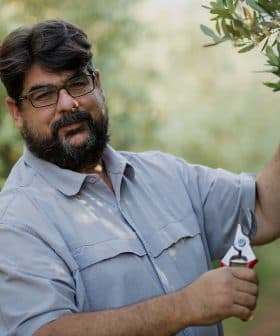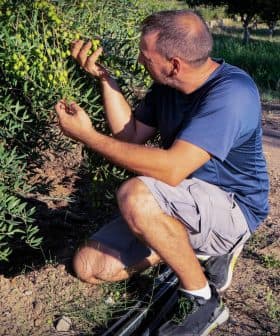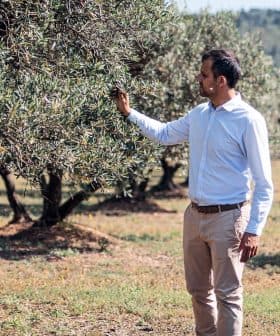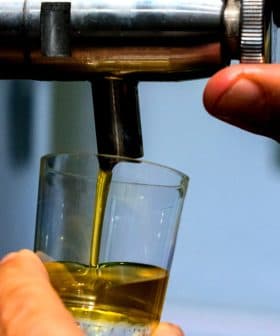 5.3K reads
5.3K readsProduction
El Niño Decimates Peruvian Olive Harvest

Peru is expected to see a 90 percent decrease in olive oil production in 2024 due to climate extremes linked to El Niño, with local producers estimating a drop from 7,000 tons in 2023 to 700 – 1,000 tons. Despite the challenges, efforts are being made to diversify olive varieties, improve oil quality, promote local consumption, and focus on exporting to smaller markets in South America and the United States, with optimism for a potential record harvest in 2025 if La Niña conditions prevail.
Officials in Peru anticipate a 90 percent decrease in olive oil production before the 2024 harvest, citing climate extremes attributed to El Niño.
Local producers estimate the country will produce between 700 and 1,000 tons of olive oil in 2024, down from 7,000 tons produced in 2023. Peru produces less than 10,000 tons of olive oil in an average crop year.
The climate forecasts predict that we will have a much more normal winter. This could translate into a record harvest in 2025.
With the development of El Niño, Peru tends to experience higher annual average temperatures. During this cycle, many olive trees did not receive the necessary chill hours to bear fruit. Heavy rains during the flowering period in the olive groves, primarily in arid southwestern Peru, lost their flowers and will not produce any fruit.
See Also:EU Protects 10 Geographical Indications from Latin American Countries“More so than the rain, the problem has been the need for sufficient chill hours,” Manuel Morales Ordóñez, the president of the Association of Table Olive and Olive Oil Producers and Exporters of Peru (Pro Olivo), told Olive Oil Times.
“The Criolla olive [which accounts for 85 to 90 percent of table olive and olive oil production] especially has a strong need for enough chill hours, and this year with El Niño, we had very high winter temperatures,” he added.
The olive harvest begins in the second week of February, with the table olive harvest starting in March and continuing through June.
Peru has an unusual location for an olive oil-producing country, with most of its olive groves located between 16 and 18 degrees south, putting the region closer to the equator than any other olive oil-producing country.
Olive trees have survived in southwestern Peru due to their location between the Andes Mountains and the coast, along with the presence of the Humboldt current, which brings Antarctic waters to the Peruvian coast and moderates the temperature.
According to Gianfranco Vargas, a Peruvian olive oil producer and president of the cultural association Sudoliva, the periodic recurrence of El Niño brings a more tropical climate to Peru, typical of other countries at the same latitude.
Along with promoting South America’s historic olive trees, Vargas harvests his own centenary Criolla trees in the Sama Valley, in the southwestern corner of Peru. “My production will not even reach 12 or 13 percent of what it normally would,” he told Olive Oil Times.

Vargas inspects the olive trees ahead of the harvest. (Photo: Eliete Vera)
Farther northwest in Pisco, about 500 kilometers from the country’s main olive-growing region, Peru’s largest olive oil producer is also anticipating a poor harvest.
“Peru is an interesting place to grow olives as we are growing in a tropical zone quite different from the typical Mediterranean olive growing climate, but it does work most years,” John Symington, owner of Oasis Olives, which also produces olive oil in Australia, told Olive Oil Times.
“However, this year, due to the very strong impact of El Niño conditions, there will be a very poor olive crop,” he added. “Our own crop is poor, and there are other growers who have a small crop, but many producers will have close to zero fruit this year. The small crop is also in part due to normal alternacy as there was a good crop in Peru last year.”
Morales and Vargas believe Peruvian olive growers need to diversify, growing more Arbequina, Coratina, Frantoio, Manzanilla and Sevillano olives. “Other varieties, such as Manzanilla, have proven to tolerate higher winter temperatures than the Criolla variety,” Morales said.
However, the challenge of shifting away from the Criolla variety lies in the country’s olive culture, which is far more focused on table olives. In 2022, a bumper year, Peru harvested about 140,000 tons of olives but produced less than 10,000 tons of olive oil.
“Normally, olives that are not considered adequate for table olive processing are sent to the mill to be turned into olive oil,” Morales said. “These are usually green olives, olives that are changing from green to black and small olives.”
As a result, Peru long suffered from a reputation for producing low-quality olive oil, but Morales said this is changing.
According to Vargas, roughly 50 percent of the olive oil produced in Peru is lampante and exported to Spain to be refined and blended with virgin or extra virgin olive oil.
About 30 percent of the annual production is extra virgin olive oil exported to Australia, the United States and neighboring countries, including Chile and Brazil.
However, with lampante olive oil prices surging to new heights in Spain, Vargas sees little motivation for producers to focus on superior grades of olive oil.
Still, Morales said Pro Olivo is working with producers to harvest their olives earlier to create extra virgin olive oil richer in polyphenols. The organization also holds workshops to improve milling techniques and help producers lower costs by optimizing pesticide and fertilizer use.

Morales believes it is necessary to improve olive farming and milling techniques to improve quality and grow consumption in Peru. (Photo: Pro Olive)
Another of the organization’s goals is to promote local olive oil consumption in Peru, which remains very low. One of the ways the organization plans to do this is by adding extra virgin olive oil to Peruvian recipes.
However, Vargas said high olive oil prices are hurting local consumption and pushing the country’s olive oil producers to turn their focus away from the domestic market. In 2023, Peru exported 3,000 tons of olive oil, 42 percent of what it produced.
“A one-liter bottle of olive oil in the supermarket used to sell for $10,” Vargas said. “Now, the same bottle sells for $20, leaving many Peruvians unable to buy the olive oil. It continues to be a product associated with the elite.”
Rising prices also mean more Peruvian restaurants are replacing olive oil with other edible oils. Vargas said the consequences of rising prices further disincentivize producers from focusing on producing higher-quality oils.
Morales sees the future of Peru as a regional olive oil exporter, focusing on smaller markets of Colombia, Ecuador and Central America along with Chile and Brazil. However, the sector’s ultimate goal is to continue increasing exports to the lucrative U.S. market.
Meanwhile, Vargas emphasized the role of developing oleotourism in southern Peru, focusing on the history and culture of its centenary olive trees. He said this would diversify income streams for producers, giving them a buffer to deal with poor harvests caused by El Niño.
With many in Peru preparing to write off the 2024 harvest, Morales is looking ahead to 2025 with measured optimism.
Morales said some meteorological indicators have made him optimistic that the El Niño cycle will end soon with the probability of a countervailing La Niña event rising.
Typically, La Niña increases the probability that Peru experiences drier weather. The last triple-dip La Niña plunged the country into drought, which Morales said is not a significant factor for most of the country’s olive groves, which are irrigated in areas with abundant aquifers.
“The climate forecasts predict that we will have a much more normal winter,” he said. “This could translate into a record harvest in 2025.”
Morales said producers could yield 10,000 tons of olive oil in 2025 based on installed milling capacity. Although, he was quick to warn that this was a best-case scenario and no one could accurately predict the final result of the upcoming 2024 harvest, let alone the following.
Vargas agreed with Morales and said if La Niña comes, Peru will have a significantly larger harvest in 2025, with many trees well-rested after two consecutive low harvests.
He added that the development of an anticyclone in the southern Pacific Ocean indicated that El Niño might soon shift to La Niña.









